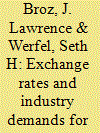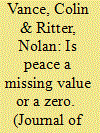| Srl | Item |
| 1 |
ID:
168330


|
|
|
|
|
| Summary/Abstract |
In this study the non-parametric method of Data Envelopment Analysis (DEA) is applied to determine the technical efficiency (TE) index of the G7 countries, when variable returns to scale (VRS) hold for the entire period under consideration (1993–2016). As inputs labor and capital are used while we utilize GDP as output. In the second stage of our analysis the DEA bootstrap approach along the lines of Simar and Wilson (2007) is applied to deal with the disadvantages of a non-parametric DEA set up. Through this procedure we investigate the relationship between the efficiency evaluation of DMUs as calculated by the DEA method, in the first stage of our analysis, and the variables of arable land, total greenhouse gas emissions and total primary energy consumption. In addition, for these variables and through the estimated regression coefficients, elasticities and marginal effects of both TE and GDP index are calculated.
|
|
|
|
|
|
|
|
|
|
|
|
|
|
|
|
| 2 |
ID:
131503


|
|
|
|
|
| Publication |
2014.
|
| Summary/Abstract |
The recent confrontation between China and the United States over currency policy illustrates a broader phenomenon: exchange-rate misalignments tend to spill over into trade policy. Although previous studies have shown that aggregate protectionist activity is positively related to the level of the real effective exchange rate, we explore this relationship at the industry level. Several industry-specific characteristics determine the protectionist response to exchange rate changes, including the degree of exchange-rate pass-through, the level of import penetration, and the share of imported intermediate inputs in total industry inputs. We find that the marginal effect of currency appreciation on the number of industry-level antidumping petitions is positive and significant only for industries with high pass-through. Therefore, exchange rates appear to induce demands for trade barriers only in industries where competitiveness is directly harmed by currency appreciation.
|
|
|
|
|
|
|
|
|
|
|
|
|
|
|
|
| 3 |
ID:
133710


|
|
|
|
|
| Summary/Abstract |
Sample selection models, variants of which are the Heckman and Heckit models, are increasingly used by political scientists to accommodate data in which censoring of the dependent variable raises concerns of sample selectivity bias. Beyond demonstrating several pitfalls in the calculation of marginal effects and associated levels of statistical significance derived from these models, we argue that many of the empirical questions addressed by political scientists would - for both substantive and statistical reasons - be more appropriately addressed using an alternative but closely related procedure referred to as the two-part model (2 PM). Aside from being simple to estimate, one key advantage of the 2 PM is its less onerous identification requirements. Specifically, the model does not require the specification of so-called exclusion restrictions, variables that are included in the selection equation of the Heckit model but omitted from the outcome equation. Moreover, we argue that the interpretation of the marginal effects from the 2 PM, which are in terms of actual outcomes, are more appropriate for the questions typically addressed by political scientists than the potential outcomes ascribed to the Heckit results. Drawing on data from the Correlates of War database, we present an empirical analysis of conflict intensity illustrating that the choice between the sample selection model and 2 PM can bear fundamentally on the conclusions drawn.
|
|
|
|
|
|
|
|
|
|
|
|
|
|
|
|